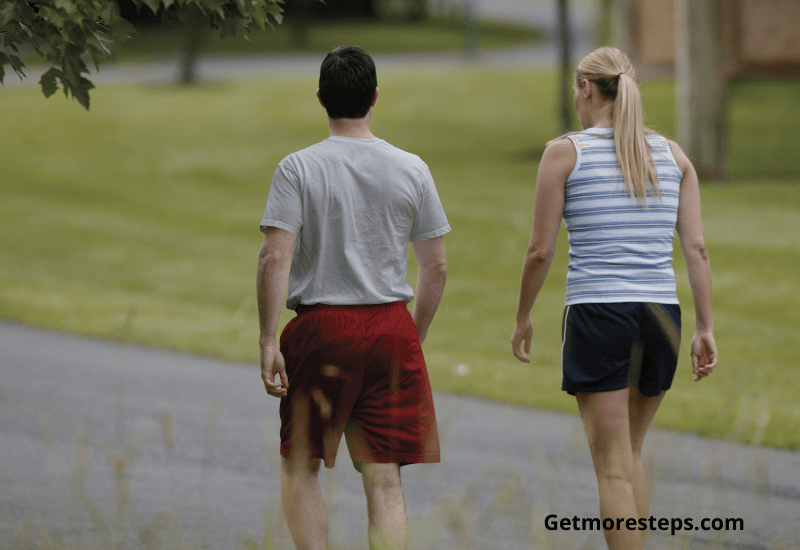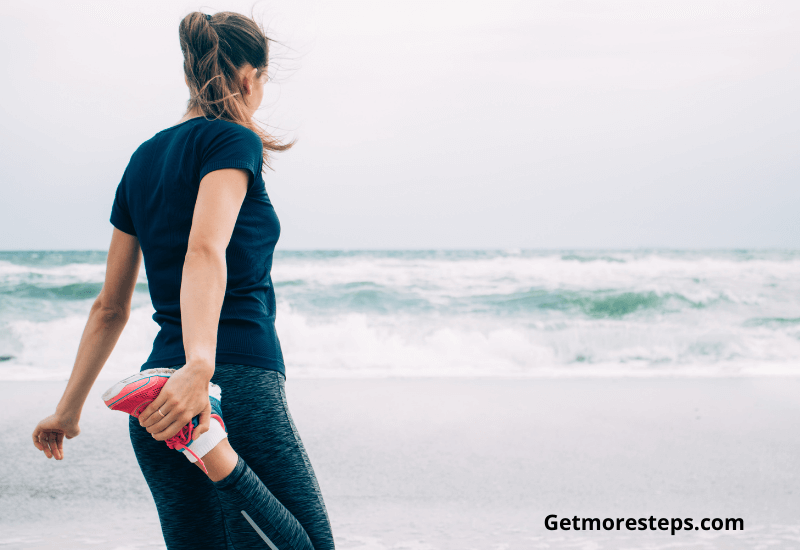If you want to know how to start walking for health, then you came to the right place! Walking is an excellent cardio workout. It boosts your metabolism, it makes you burn fat, it’s enjoyable, and on top of this, it doesn’t cost anything! So how do you get started? Well, It’s easier than you may think. You just need to follow a few simple steps, and you are good to go! In this article, you find everything you need to know so you can start walking as soon as possible.
Contents
- 1
- 2 What to Do Before You Start Walking
- 3 Get Prepared To Walk
- 4 What Shoes for Walking?
- 5 When to Replace Your Walking Shoes?
- 6 Eating and Walking
- 7 What to Carry When Walking
- 8 Warm-up and Cooldown
- 9 Walking Plan
- 10
- 11 Week 1:
- 12 Walk With a Good Posture
- 13 How to Breath Efficiently?
- 14 Walking for weight loss
- 15 Things You Should Avoid Doing
- 16 Conclusion
What to Do Before You Start Walking
Get a check-up
It’s always advisable to see a doctor before you begin any workout if you are over 60, suffer from a disease, have chest pain, smoke, are pregnant, or have a family history of heart diseases. Talk to your doctor and ask him if it’s Ok to start walking for fitness.
Get a good pair of walking shoes.
Avoid wearing worn-out or ill-fitting shoes for your workout. It can cause serious injuries. Go to an athletic shoe store and get a supportive and well-fitting pair of walking shoes. Fitness walkers love to use running shoes for their walking sessions because they are lighter, more flexible, and well-cushioned.
Get moisture-wicking clothing
You want to be as comfortable as possible when you walk. My best advice would be to get some clothing in a lightweight material. For example, fabrics like DRI Maz or SmartWool wicks away moisture from your skin and allows you to stay cool in the summer, warm in the winter, and dry when it’s humid outside. Any Cotton fabric will absorb sweat like a sponge and will make you feel uncomfortable.
Get Prepared To Walk
Choose Your Location
Find a place you feel comfortable walking. It could be around your block, in a park, or around the town where there is almost no traffic. Just make sure the place has flat and smooth terrains. You don’t want to begin your workout on steep and curved surfaces. This could be too intimidating. If you prefer to walk indoors, you can do it on your treadmill at a moderate speed or walk in place. There are great programs for beginners on Youtube.
Get Your Audio Player
If you walk with a friend, you might not need an audio player. But if you plan on walking alone, you should consider listening to music or an audiobook or podcast. It increases stimulation and keeps you motivated. So don’t forget your MP4 player!
Plan, Plan, Plan!
Set some objectives and start slowly, especially if you didn’t exercise for a long time. Write your goals down. It will keep you on track and will make you want to do more. After each walking session, it’s always good to cross off the goal you have written down. It will give you a sense of satisfaction and more confidence.
Health benefits of walking
Did you know that 70% of Americans and Australians say walking is their primary form of fitness? So why Is that?
It has been proven that walking 30 minutes every day improves overall health. Walking is good for the mood; it fights depression, especially when meditation is integrated into the workout routine.
Are you having trouble remembering things?
Walking has been shown to increase neuronal gain control in the brain, enhancing the capacity to learn. A new University at Buffalo study has shown that walking at least two hours per week reduces the risk of heart failure. Also, many studies have shown that walking minimizes the risk of colon and breast cancers.
The good thing is, you have to walk only 150 minutes per week to get health benefits.
According to Robert Sallis, M.D., a sports medicine doctor and family physician, you don’t need to walk long distances marathon and exhaust yourself; just 150 minutes per week can improve your overall health.

What Shoes for Walking?
As I said earlier, it’s a must to wear the right shoes as this is what will make your walk comfortable and safe. Without them, you may get injuries such as knee pain, Achilles tendonitis, plantar fasciitis, hip pain, and other pain caused by walking in the wrong shoes.
Neutral shoes: If you are a neutral walker, meaning your foot doesn’t roll too far inward (Overpronate) or roll outward (supinate) as you are walking. In other words, your ankle remains aligned each time your foot makes contact with the ground during the landing phase of the gait cycle. Then, you’ll need neutral shoes, they will give the right level of support without reducing the speed of rotation. And they don’t restrain the movement of your foot when you walk. There are lightweight neutral shoes that will fit the bill but for fitness walking, running shoes are usually the favorite choice for walkers.
Stability Shoes: These are designed for walkers who overpronate ( The ankle rolls inward). These shoes have additional features in the midsole to support the foot, ankle and help align the leg when walking. Overpronation can cause injuries, so before you begin to walk, you should check your feet’ pronation with an expert to determine the type of shoes you need.
Motion Control Shoes: Motion-control shoes are for those with severe overpronation (When the ankle rolls drastically inward) when standing or walking. These usually have lots of cushioning and heavy-duty support features to stabilize the ankle and align the foot. The support is placed under the arch as well as in the heel.
Heel to toe drop: As walkers land fist on their heel and roll through the step, they need a low heel drop walking shoe. This means shoes with a heel that sits not too high than the forefoot of the shoes. The best for walking would be a heel drop of less than 8 mm, with 4mm or less.
When to Replace Your Walking Shoes?
Shoes aren’t designed to last forever, especially athletic shoes. They wear out even quicker. So how do you know when it’s time to replace your walking shoes?
As a rule of thumb, you should replace them every six months if you walk an average of three to four hours per week. And If you walk seven hours per week, meaning 60 minutes a day, you should replace your shoes every three months. If you count the miles, replace them every 350 to 500 miles.
Eating and Walking
Is it better to eat before you go for a walk? Is it better to walk on an empty stomach? What to eat before walking? These are the questions most walkers beginners ask, including me when I started. Know that walking is a low impact exercise, so there is no problem to have a light meal about an hour before your walk. If you are not hungry or don’t have the time to eat, get a snack like a banana or energy bar. It will fill you up and give you the energy you need to walk. Try to eat light and healthy food. You don’t want to feel sick or too heavy during your workout. Spoil your body with a light meal that contains low carbs and protein food.
Here are some excellent options for you: Light meals to eat an hour before your walk.
- Scrambled eggs, veggies, and avocado
- Chicken, whole grain rice, and steamed vegetables
- Sandwich on whole-grain bread, lean protein, and a salad
- Low-Fat Cottage Cheese with whole grain rice cakes.
- Greek yogurt with granola and berries
- Apple slices with peanut butter
- Hands full Nuts
- Banana
- Natural Energy bars
Never walk on an empty stomach; it could make you feel tired or dizzy. Also, drink some water before or during walking.
What to Carry When Walking
Water
When walking, your body loses water. You need to drink, so you don’t get dehydrated. How much water do you need? Neither too much nor too little. A good rule of thumb would be to drink 3 to 6 fluid ounces of water every 15 to 20 minutes. So if you plan to walk 20 minutes, you might drink after your walk. Or, if you have a water bottle carrier, you can drink during your walk.
Sports Drinks
If you walk for more than two hours, you might want to add some sports drinks instead of water. The reason is that sports drinks contain carbohydrates, which help your body to absorb fluid more quickly. Another thing you can do is to eat salty food such as pretzels. It also helps with water absorption. Try to op for whole-wheat flour pretzels if you choose this option.
Protection against the sun
In the summer, like in the winter, the UV rays are damaging your skin and eyes. So put your polarized sunglasses on and protect your skin with sunscreen. Choose preferably waterproof sunscreen, so it doesn’t run in your eyes if you sweat.
Storage
An armband is helpful when you need to store your keys, ID, phone, and even some cash. So don’t forget to bring it with you.
Safety Precautions
If you plan on walking late in the evening or early in the morning, think about wearing reflective gear to attract the drivers’ attention so that they can see you.
Warm-up and Cooldown
It’s important to warm up before walking because it increases your heart rate gradually, and it helps to stretch your muscles and joints, which leads to a greater range of motion. There are two types of stretching Dynamic and Static. Both stretching are excellent, but they need to be used for different purposes. You should do Dynamic first to stretch your muscles and then Static to relax and cool down your muscles.

Walking Plan
Walking is easy, and the good thing is that it’s free and doesn’t require any special knowledge or equipment, except for a good pair of walking shoes. When starting with walking, it’s essential to get a plan; it will help you stay on track. Here is a 4-week walking plan.
Easy: You can talk and even sing while walking. Breathing is easy.
Moderate: Pace increase, you can still talk, but you are not able to sing.
Brisk: You are more short of breath, and you are only able to speak briefly.
Week 1:
- Dynamic Warm-up – 5 minutes
- Walk a moderate pace – 10 minutes.
- Static cool down – 5 minutes
- Repeat 5 times a week
Week 2:
- Dynamic warm-up – 5 minutes
- Walk a moderate pace – 15 minutes.
- Static cool down – 5 minutes
- Repeat 6 times a week
Week 3:
- Dynamic warm-up – 5 minutes
- Walk a moderate pace – 20 minutes.
- Static cool down – 5 minutes
- Repeat 6 times a week
Week 4:
- Dynamic warm-up – 5 minutes
- Walk at a moderate pace – 30 minutes.
- Static cool down – 5 minutes
- Repeat 6 times a week
Dynamic and static stretches are important to loosen the muscles and prevent injuries. But If you don’t have the time to do these exercises, you can replace them by doing 5 minutes of walking at a slow pace before and after your workout.
Walk With a Good Posture
Walking looks simple, but did you know that your posture makes a big difference in your walking speed? Using the right posture will help you relax your neck and shoulder, avoid knees and back pain, and breathe correctly. Here is how you need to walk.
- Hold your head straight
- Keep your shoulders down (not too high, not too low)
- Put your arms at 90 degrees
- Look forward, not at the ground
- Keep your back straight
- Keep your chin parallel to the ground
- Tighten your stomach muscles
- Move your arms from front to back while walking
- Start walking and roll your foot from heel to toe.
How to Breath Efficiently?
Breathing, when done correctly, decreases muscle tension, reduces stress on your body, keeps you injury-free, and gives oxygen to your muscles when you walk. The easiest technique is to breathe in through your nose and exhale through your mouth.
Here is how you do. Breathe in for four, out for four, where your breathing rhythmically even. Walk in cadence, where your breath and your strides follow that rhythmic count of four. This breath is called stair breathing. In other words, each stride links with your breath.
You should be able to walk at a pace at which you can carry on a conversation comfortably. But your aim is to walk fast, you will want to increase the pace, which requires more effort. And this will result in faster breathing. However, the principle remains the same, you should breathe in for four and out for four, but faster.
Walking for weight loss
Walking is an excellent way to burn fat, especially if you walk at a brisk pace. In fact, it is one of the best workouts to lose weight, but you also need to adopt good eating habits.
This doesn’t mean you have to eat like a rabbit. On the contrary, you can still enjoy delicious food and get rid of refined grains, fried food, sweets, and unprocessed meats.
However, don’t lose too fast; it’s the best way to regain all the weight lost. According to researchers, losing more than one to two pounds per week is unhealthy. We all have different metabolism, and some people lose slowlier and others quicker. So if you don’t see results right away, just stick to your goal.
Things You Should Avoid Doing
- Don’t ever wear worn-out shoes. Walking in the wrong shoes can cause serious injuries.
- Surpassing your limits is excellent, but if you do too much too soon, you may not want to continue walking, and it can also cause you injuries.
- Bad posture can lead to injuries, so check your posture before and while you are walking.
- Never start walking without drinking water and on an empty stomach. You could get dehydrated. So, before you head out, make sure to drink and eat approximately an hour before your walk and if it’s a light snack, you can eat it half an hour or even 15 minutes before your workout.
- Avoid wearing cotton clothes as it tends to absorb sweat. Look for fabrics like DRI Maz or SmartWool. They wick away moisture.
Conclusion
Walking is relaxing and it’s a simple workout that you can do almost anywhere, and it doesn’t cost anything. To start walking, you only need a good pair of shoes, motivation, and you are good to go! Just remember to breathe correctly, and maintain a good posture, and, most importantly, stick to your goal!
What about you? Do you walk? If so, how did you started? I would love to know.

I don’t know about you, but I love my feet because they allow me to walk and go wherever I want to go. Without them, I would be lost! So I always spoil them with a good pair of walking shoes to make sure they are as comfortable as possible. If you take care of your feet, they will take care of you and your health. Well, fitted shoes will protect them and allow you to get more steps without pain!
Read more about me

